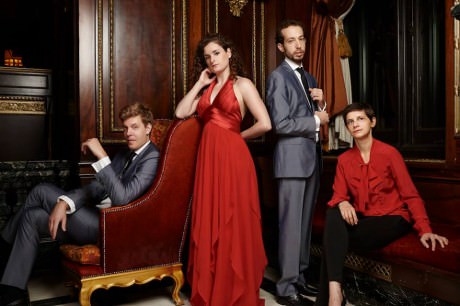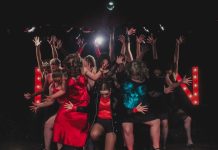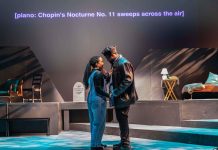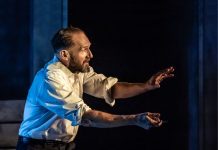How much do you re-interpret music that was written 100 or 200 years ago? This eternal question has an unequivocal answer in the hands of a young ensemble like The Ariel Quartet: Just do it. The results are imperfect even as they clearly intrigue crowds and provoke conversation, as they certainly did on November 20, 2014, at the Israeli Embassy.

The Ariel Quartet, all still in their 20s, is already a veteran, international presence as the group was formed in their teens in Israel, eventually to be joined by German violist Jan Grüning. Currently in residence at the University of Cincinnati’s Conservatory of Music, the Ariel is known for performing Beethoven’s entire output of 16 string quartets, especially in a full annual cycle at New York’s SubCulture concert venue in lower Manhattan.
Indeed the Ariel is on its most solid ground when interpreting Beethoven and later composers, edging into 20th century tonalities (and atonalities which depart from any recognizable key). They’re on somewhat shakier ground when trying to put their stamp on pure classicism, as in a quartet by Joseph Haydn that was first up in Thursday’s recital, although it’s worth noting that I immediately heard debate about it in the audience (which is a good thing).
Very little can be described about the Ariel Quartet without noting the outsize presence of violinist Alexandra Kasovsky. Surely the most manic violinist I’ve ever witnessed – whether in the concert hall, on the street corner or in a subway station – Ms. Kasovsky almost leaps out of her chair approximately every fourth bar. With her lead, the quartet as a whole is practically choreographed, with the four members repeatedly leaning toward one another in what often is entertaining but also at times an overemployed tic that seems an attempt to impart profundity even to the most straightforward of musical passages.
There’s no question these four are already among the world’s experts in Beethoven’s music for string instruments. On Thursday they performed Beethoven’s String Quartet #11, one of those pieces that carries a non-entirely-descriptive “nickname” of the Serioso Quartet. The reference is to the opening passage in the forbidding key of F minor that rips off a series of notes setting a dark tone. If I told you that it actually has the shivering quality of the rapidly played string notes in the “Winter” suite of Vivaldi’s The Four Seasons, then I think it provides a better idea.
The Ariel were effective in this entire quartet, biting into the notes and making extreme contrasts among tempos. Particularly effective were the passing around of fast passages to Mr. Grüning on the viola and Amit Even-Tov on the cello, with Mr. Grüning’s hair flying (hard not to notice, as at nearly 6½ feet tall he is surely the tallest viola player I’ve even seen), and Ms. Even-Tov’s relatively calmer manner compared to her quartet-mates only accentuating her fluent bow movements all around her cello.
The larger issue was the Ariel’s treatment of Joseph Haydn’s Quartet in G Major, identified in one among the many Haydn numbering systems as Opus 76, Number 1. No quartet could start in a more charming manner, with 4-bar solos passed up the line from cello to viola to second violin to first violin – and with each initial violin line acquiring a partner (Ms. Even-Tov’s cello to Gershon Gerchikov’s second violin and Mr. Grüning’s viola to Ms. Kasovsky’s first violin).
The issue is that Ms. Kasovsky simply doesn’t let the music be, biting into notes with her bow to create harsh accents where they’re rarely placed, and vastly exaggerating tempo changes as if the music were somehow “telling a story” rather than serving as the kind of “absolute music” (music for its own sake) that was most common of instrumental music of Haydn’s 18th century milieu. In service of these devices, Ms. Kasovsky often simply lets her intonation and her tone go a little south.
At times, the quartet’s sudden biting entrances in the Haydn literally made the audience around me jump in their seats. Now that’s impact! I suppose if that turns half the audience into devotees, that’s something to the good for classical music. Exclamations of “wasn’t that something?” after the piece gives you an idea of the ambiguous buzz in the room after the piece.
The Ariel completed the program with Maurice Ravel’s Quartet in F Major. Here the group’s interpretive maturity was often on display, with the “rubatos” (or free play with the tempos) usually very appropriate. Once again, though, Ms. Kasovsky’s not-infrequent out-of-tune playing created a dilemma. Often in this quartet, Ravel situates beautifully close and complex harmonies among the three lower instruments, requiring the first violin to render a melody high above the other three. A simple and accurate stroking of the notes by the lead violin rather than overindulgence in the “stage business” of Ms. Kasovsky’s bow-work might more readily produce the satisfying sound that Ravel was going for.
The Ariel certainly will be back in the area, both in D.C. and in the Shenandoah Valley, this season so that more audiences can check out their style for themselves. It will be fascinating to see how this group’s style evolves and if its place on the string quartet continuum – clearly right now on the daring side, with all the benefits and risks attendant to that – changes at all. It’s certainly a conversation piece for everyone who sees and hears them.
Running Time: One hour and 40 minutes, with one 15-minute intermission.
The Ariel Quartet performed Thursday, November 20, 2014 at the Embassy of Israel – 3514 International Drive NW, in Washington, DC. For future concerts, see their events calendar. For future events in the Embassy Series presenting concerts at various embassies around the city, see the Embassy Series’ website.





